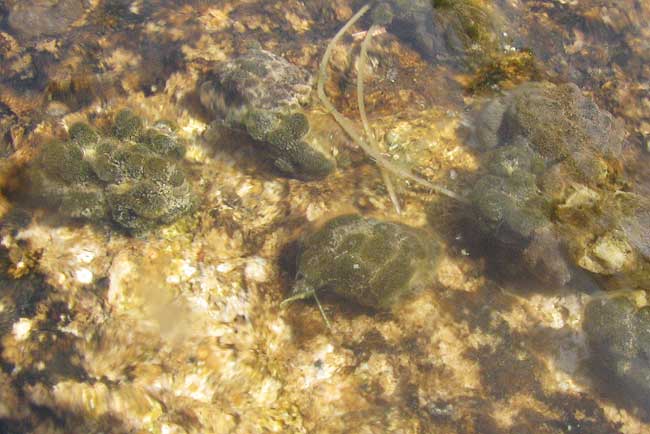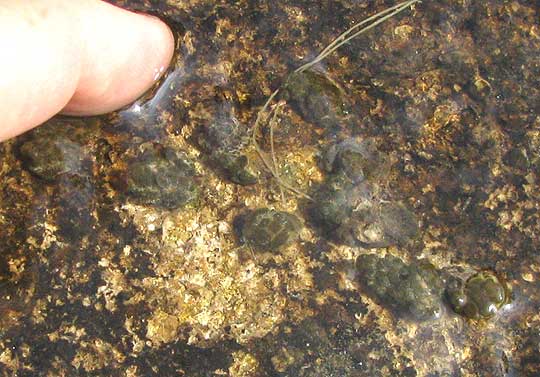Excerpts from Jim Conrad's
Naturalist Newsletter

from the August 4, 2013 Newsletter issued from the Frio Canyon Nature Education Center in the valley of the Dry Frio River in northern Uvalde County, southwestern Texas, on the southern border of the Edwards Plateau; elevation ~1750m (~5750 ft); N29.62°, W99.86°; USA
FRESHWATER BRYOZOAN
At a low-water crossing of a one-lane gravel road a couple of miles north of the Center, clear water trickled from a metal culvert through the knee-high embankment bearing the road. The water, about 1/8th of an inch deep (3mm), sparkled as it issued onto a flat concrete apron before cascading over the edge into a small pool. Where water spread over the apron the submerged concrete was carpeted with a slimy mingling of aquatic algae, fungi and microbes. In one spot there was something unusual, though. Below ,you can see what I'm referring to -- the pea-sized, nodular, gelatinous-looking items below and to the right of my finger:

They're shown closer up at the top of this page.
They looked soft and jelly-like, so I thought they might be frog eggs, but when I nudged one with my finger it was hard, like rock. Maybe the gloss was caused by a very thin living membrane or layer. Thinking the objects might be like barnacles cemented to the concrete, with fair force I dislodged one with a thumbnail, carried it home, and beneath the dissecting scope got a view of its surface, which under the scope appeared honeycombed with innumerable tiny holes, as shown below:

Flipping the object over, the surface that had made contact with the concrete apron displayed a pattern like you might get by cutting across soggy spaghetti that's been squeezed into a compact mass, as seen below:

So, what did all this mean?
Years ago I heard about the existence of freshwater sponges, so were these sponges? Sponge bodies are full of pores and channels allowing water to circulate through them. After the water passes through the sponge body it enters a central cavity and is discharged through a special hole. In the spaghetti picture there were no channels or pores through which water could circulate, nor did the bodies show a central cavity or pore.
At this point it occurred to me that I'd seen the compacted spaghetti pattern in rock-like fossils of creatures living millions of years ago. The creatures had been bryozoans.
Though they didn't look like our organisms, on the beach in the Yucatan we've come upon the White Tangled Bryozoan shown at https://www.backyardnature.net/yucatan/tangled.htm.
Our Lacy Crust Bryozoan that floated up on a bottle one day resides at https://www.backyardnature.net/yucatan/bryozoa2.htm.
Our oceans have harbored bryozoans for millions of years, but can they turn up in small, intermittent, freshwater streams like the Dry Frio in southwestern Texas? On the Internet I found that freshwater bryozoans do exist, and that the gross structure of some of them is like compacted spaghetti.
Though I couldn't find anything on the Internet looking like our finding, I did encounter lots of information on bryozoans provided there by Dr. Timothy S. Wood, Professor Emeritus in the Department of Biological Sciences at Wright State University in Ohio. I sent our pictures to Dr. Wood, who was generous enough to reply:
Bryozoans constitute an animal phylum all to themselves. To put that into perspective, there's the "Chordate" Phylum more or less consisting of all animals with backbones; there's the "Annelid" Phylum of segmented worms; the Mollusk Phylum, the Sponge Phylum and many other phyla. In other words, in terms of the Phylogenetic Tree of Life, there's more difference between a sponge and a bryozoan, which are in different phyla, than a fish and a human, which belong to the same phylum. Our bryozoan, then, is a whole other kind of living thing than we're used to dealing with.
Our pictures show colonies of bryozoans. The individual bryozoan animals themselves are microscopic. Each pore observed on the surface surely was occupied by one of the tiny creatures, called a zooid. Bryozoan anatomy is so surreal and unlike anything we see in everyday life that to grasp what they're about you might enjoy visiting the Thinkquest.org website dealing with them at http://library.thinkquest.org/26153/marine/bryozoa.htm .
So, this is a wonderful discovery, one that'll encourage me to start paying more attention to scum and mire.
Now if I can only find those freshwater sponges...